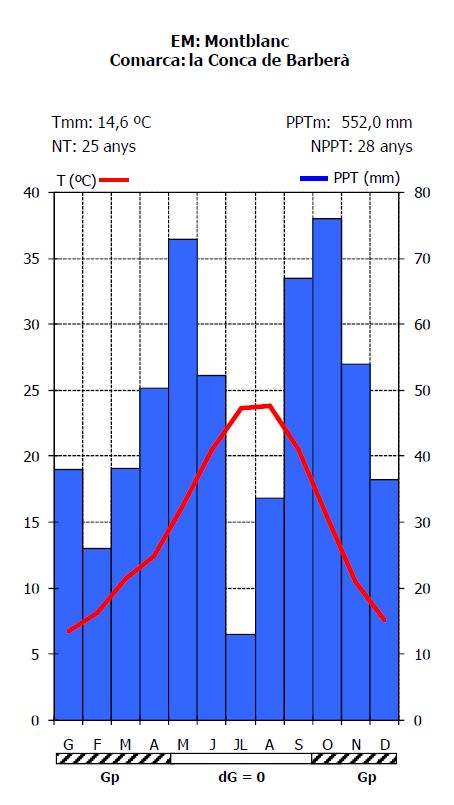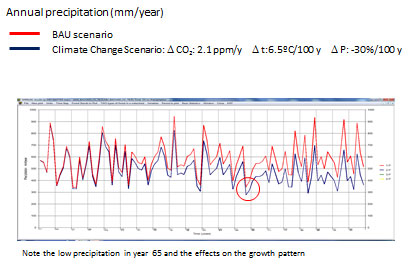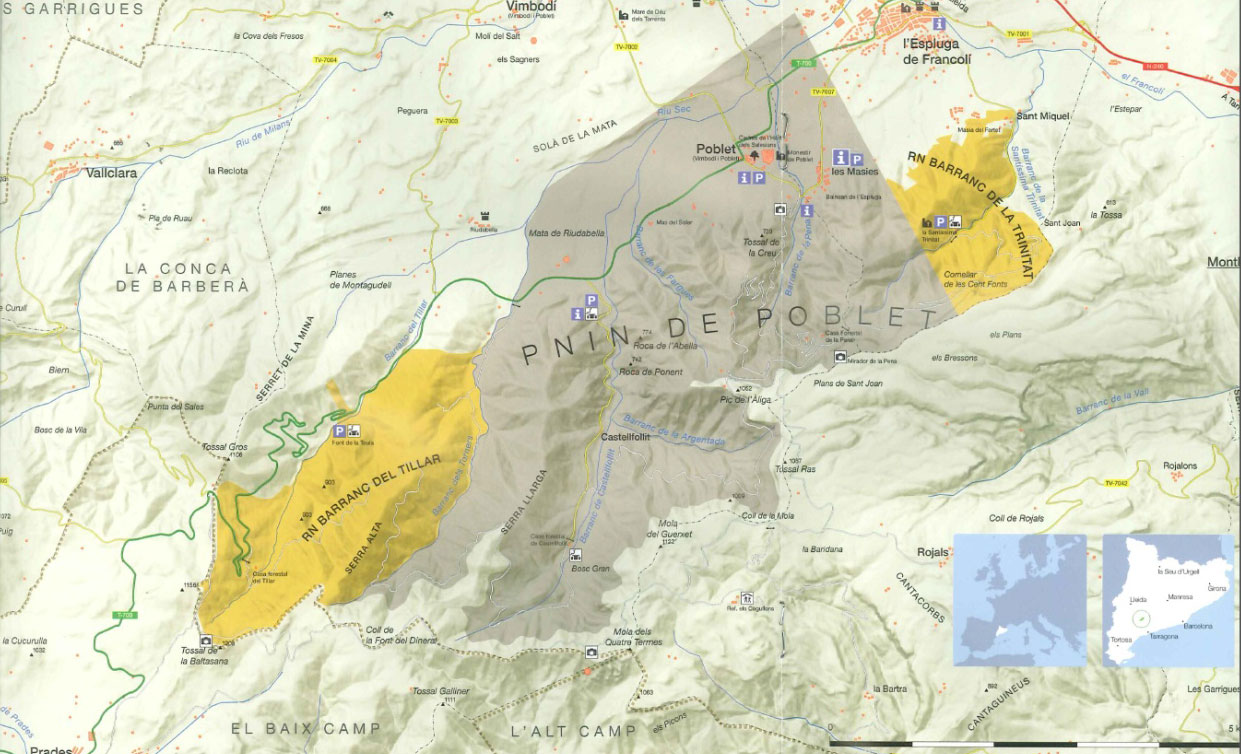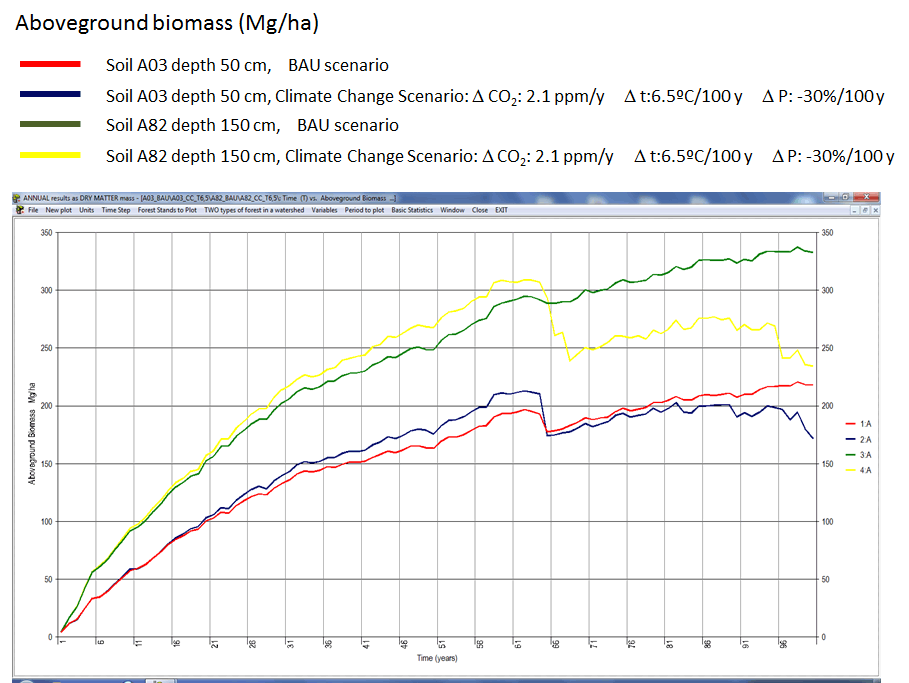General information about case study
Poblet Natural Site of National Interest (NSNI) is a protected natural area with a size of 2,460 ha situated in the province of Tarragona in the SW of Catalunya (41°17′34″N 1°02′42″E, Figure 1). It forms part of the Prades mountains, a large forested area of 26,000 hectare with both public and private ownership. In Poblet NSNI, two main types of landscape are clearly visible: in the Prades mountains, the relief is markedly mountainous (the Prelitoral mountain range) while the northernmost part of the NSNI is characterised by the flatter land around the Sec river valley (the Central Catalan Depression). The protected area is owned and managed by the regional government of Catalunya (Generalitat).
Poblet NSNI is part of the administrative district of Conca de Barberà. The size of the district is 650.24 km2 and it is populated by 20,057 citizens (30.85 inhabitants/km2). Regarding the land use in this district, almost half of it is cultivated land, 27% of dense forest and most of the rest under shrubland. The regional economy depends on agriculture. The main products are cereals, vineyards, almond and hazelnut. The main crop is wheat, followed by barley. There is very little livestock.
Current climate, climate change scenarios and geology
The climate of the Poblet area is typically Mediterranean, with some variations. There is a tendency towards a continental climate, and of course there are the logical effects of increasing altitude, which lead to a mid-mountain climate. The predominantly northern aspect of the Site also affects the climate. The average annual temperature is 13.2ºC and average annual rainfall is between 550 and 600 mm. The climate diagram indicates severe drought stress in the summer months July and August (figure 2).

Figure 2. Climate characteristics of the weather station in Conca de Barberà district (source: Servei Meteorològic de Catalunya, Generalitat de Catalunya).
Climate change is expected to have an effect on temperature, but also on precipitation (figure 3). For the simulations used to optimize management under climate change for Poblet, hourly data for the next hundred years were produced by the Gotilwa+ weather generator using a regional climate model for Catalunya run for a climate scenario close to the SRES A1B (Barrera-Escoda and Cunillera 2010). The regional translation of this climate scenario predicts a 2.1 ppm/year increase in CO2, a 6.5°C/100 year increase in mean annual temperature, and a 30%/100 year decrease in annual precipitation. Figure 3 shows the evolution in precipitation over the next hundred years as simulated by the Gotilwa+ weather generator.

Figure 3: Evolution of precipitation (in mm/year) in Prades mountains as modelled with the Gotilwa+ weather generator. Note the low precipitation in year 65, which affects the growth of the forest.
The altitude of the Natural Site varies between 400 m in the lowest parts and 1,201 m in the extreme SW of the protected area (Tossal de la Baltasana). The geology of the Site of Poblet is conditioned by the fact that it belongs both to the Prelitoral mountain range and the Central Catalan Depression. The two areas are separated by the Poblet fault, which runs roughly northeast to southwest. The small area within the Central Catalan Depression, in the lower part of the Site around Poblet Monastery, consists almost entirely of Quaternary materials of the same type as the terraces of Francolí. The prelitoral mountain area is made up of a Hercynian basement, consisting mainly of grey and black slate, quartz sandstone, sulphuric horizons, and conglomerates. Above the basement in some parts of the Site there are Triassic materials with dolomite and limestone.
Forests in Poblet NSNI
The forest of Poblet is an ancient forest which historically belonged to the nearby Cistercian monastery of Poblet. It is one of the best preserved forests in the Tarragona province. Thanks to its varied geology and rugged topography Poblet has a wide variety of plant communities in a relatively small area. The following forest types are well represented in the NSNI: holm oak woods with Viburnum (Quercetum ilicis galloprovinciale), evergreen oak groves (Quercetum mediterraneo-montanum), deciduous oak woods (Violo-Quercetum fagineae), shrubby oak woods (Buxo-Quercetum pubescentis) and Pyrenean oak groves (Cephalantero-Quercetum pyrenaicae). In addition, there are also small communities dominated by Scots pine (Pinus sylvestris), maritime pine (Pinus pinaster), black pine (Pinus nigra salzmannii) and Aleppo pine (Pinus halepensis). Of particular interest is the community of Pyrenean oak (Quercus pyrenaica), as it is the only one of its kind in Catalonia. Also of interest is the presence of the yew (Taxus baccata) and holly (Ilex aquifolium), as they are protected species. The lower elevations are mainly covered with grape vines, which have a strong tradition in La Conca de Barberà, for the production of local designation of origin wines and sparkling wines (cava).
Stakeholder and demanded ecosystem services
Poblet is a national forest with a long history and a long management tradition. Because of this reason its ecosystem services and stakeholders stretch out far beyond the local level.
In the first half of the 20th century the forest was still very important for its provisioning services, mainly fuelwood and charcoal production. In the second half of the 20th century the coppice system in the broadleaved was abandoned and some parts of the forest were restored using pine plantations. In the last decades low incomes from wood and increasing labour costs have nearly stopped all tending practices.
Occurrence of forest fire is a major disservice for Mediterranean forest in general, causing huge costs for prevention, control and aftercare. The biomass accumulation in the forest of Poblet during recent decades has increased the fire risk and observed fire damage.
An ecosystem service of the NSNI which has strongly increased in recent decades is the recreation function. The forest is visited by cultural tourists, hikers, mountainbikers and mushroom pickers. The economic value represented by mushroom picking is undoubtedly the highest among its ecosystem services.
Today the main management motivation is to maintain forest health and forest regeneration.
SFM governance
The conservation and management of the forest is executed by a professional team of forest managers of the Generalitat. Because it is a protected area, they are supported by a management commission of stakeholders and experts. There is a long tradition of forest research in the area, which has certain interaction and effect on the forest management.
The Generalitat has set up a pilot trial to regulate wild mushroom foraging in in the Poblet NSNI in order to enhance forest management and rural development. This is the first time that the Catalan government has regulated this activity and regulations shall apply to government-owned forests in an area that is highly popular among mushroom foragers. In accordance with the pilot scheme, foragers have to obtain a permit at a cost of 10 euro per season which allows them to forage for wild mushrooms in an area of 3,000 hectares. All money obtained will be directly reinvested in initiatives to improve the mycological habitat of the regulated area.
Are the tree species in the forest sensitive to climate change?
Most tree species occurring in the area are typical Mediterranean tree species which are medium to extremely drought resistant. It means that they have low risk of cavitation due to drought. The most serious threat of climate change in the area is the increased occurrence of long dry spells. Even Mediterranean species can suffer carbon starvation due to these dry spell, as they need to consume their mobile carbon reserves to overcome such periods. If too recurrent, mobile carbon reserves cannot be replenished in time, with vitality loss as a consequence. This may be the case for holm oak. Eurosiberian species like Scots pine, who find some of their southernmost distribution areas in these mountains are directly threatened by climate change. Scots pine has no possibility to migrate to higher elevations given that they occupy already the highest zone of this geographically isolated mountain.
Will the risk profile of tree species change under climate change?
Tree species like holm oak that were perfectly adapted to the area in former time show decrease in vitality and even mortality due to recent long drought periods, which probably causes carbon starvation in the trees. Other species that were already at the edge of their distribution range, like Pinus sylvestris increasingly suffer from dieback due to drought stress. The general risk profile of all species changes because of increased fire risk.
Assume that current management (BAU) is continued: Is it possible to achieve current goals also under climate change conditions?
In Poblet forest just like in most Mediterranean forests in southern Europe, BAU practices is no stand tending and a clearcut or a destruction by fire at variable age. Simulations show that the BAU management under climate change leads to a decrease in biomass production. The reason is that the high stand density of a BAU management in combination with increased drought stress leads to increased competition and mortality. The BAU leads also to a serious decrease in water use efficiency (table 1). This example shows the huge potential of management to keep ecosystem services on an aceptable level under climate change. These large differences in management outcome were also observed for other ecosystem services.
Table 1. water footprint (m3 of water/m3 of wood) in Pinus sylvestris.
|
Soil depth cm |
optimal management |
no management |
|
50 |
584 |
782 |
|
150 |
739 |
1263 |
Which adaptive measures appear as suitable response to the changing climate in order to sustain the provision of demanded ecosystem services? What is the recommendation to the forest manager?
Simulations show that climate change leads to losses in wood production and Soil Expectation Value (SEV) by about 15%. The effects become particularly visible after 2050 (figure PO-1). During the first decades of the simulation under climate change we even observe slightly increased tree growth (Figure PO-1). This is the consequence of CO2 increase combined with temperature increase. Note that the optimal temperature for net photosynthesis of Scots pine is about 27°C at 400 ppm of atm. CO2, which is over the temperature at present. This positive effect of climate change on growth rates disappears and turns into a strongly negative effect when the water availability is reduced beyond a certain threshold reached during the second part of the 21st century after the occurrence of an extreme drought event, with serious consequences for the tree growth in the following years. A downward evolution of basal area and standing stock illustrates a negative growth, which is explained by so-called carbon starvation, a long lasting shortage of metabolites in the plant.
Under climate change and even under present climate there are large differences in Soil Expectation Value (SEV) between the BAU and the best possible management scenarios, which means that management is an effective tool to adapt to climate change. The best management scenarios (with best SEV, highest wood production – WP – and highest water use efficiency – WUE) for Scots pine under climate change consists of one precommercial thinning, two or three thinnings and a final cut, with a total rotation length of about 60 years. In general more cuts and longer rotation lengths are found optimal for more drought sensitive sites. Concerning optimal management, there are no large trade-offs between SEV, WP and WUE.
In general managers are recommended to follow a more intensive management which reduces canopy density. The effect of this is a decrease of competition between trees, which means more water available per tree, less mortality, and better overall growth performance.
How did you come to your conclusion(s)? Which tools and methods did you employ?
In order to support the development of optimized adaptive forest management scenarios for the Poblet area, a new forest management decision support tool was constructed. This system integrates the dynamic forest simulation model GOTILWA+, based on physiological processes controlled by climatic and edaphic factors and able to predict forest development under different climate scenarios and management options with a Particle Swarm optimization algorithm that supports in rapidly finding the optimal combination of decision variables (the number, timing and intensity of thinning and the rotation length) to maximise a given management objective under a certain climate – management scenario. Two climate scenarios were applied: current climate and Climate Change (A1FI scenario, IPCC) using daily climate data. Three different management objectives have been tested: (1) timber profitability (soil expectation value, SEV) (€/ha), (2) wood biomass production (WBP) (Mg/ha/year), (3) stand-level water use (WU) (m3 of water/m3 wood produced) and a fourth objective, crucial for the management of Mediterranean forests, a composite index of Fire risk and Damage. The decision variables (i.e. the variables to optimize) are the time between thinnings and the basal area remaining in the forest after each particular thinning (as a measure of the thinning intensity). The age at which the last thinning takes place defines the rotation length. Other variables such as the time of the tending or preparatory thinning, the remaining density of trees after tending, the threshold for DBH size of these remaining trees, as well as the threshold size of the trees cut during the commercial thinning have been kept as constant values. Further exploration of the effect of the changing values of these variables on the final optimized results is to be explored in future steps. The results mentioned in these pages have been obtained with a constant density of 1200 trees/ha after tending with DBH >= 7 cm. The tending has been always applied at the age of 12 years. When the density of trees with a DBH >=7 cm at age 12 is lower than 1200 trees/ha, the remaining density is reduced to this density in order to keep trees with a DBH >= 7 cm. Analogously, at each commercial thinning intervention, all the trees cut have to be trees equal or bigger than 10 cm in DBH. This is a main commercial restriction which has important effects on the final results. An important effort was also undertaken to construct user-friendly interfaces that facilitate the selection of climate scenarios, management objectives, site variables, economic parameters, etc. to the user. These interfaces also provide visual and summarized information on the optimal forest management strategies for the selected variables. It has become a user friendly but rather complex tool integrating in a unique way a mechanistic model and a management optimization algorithm. We do not expect this tool to be used by field managers, but it is an interesting tool for scientific analysis, advanced forestry and ecology students, or consultants preparing forest management plans.
The outcomes of the decision support system were confronted with expert knowledge of the field managers, and with experiences and published results from decades of climate change related research in Poblet area, conducted by CREAF, UB and other institutes. Conversion experiments in holm oak coppice towards high forest showed for example that thinning improves vitality and growth under drought stress.
Some related papers:
Lopez B., Gracia C.,Sabate S. and Keenan T. 2009. Assessing the resilience of Mediterranean holm oaks to disturbances using selective thinning. Acta Oecologica, 35 pp:849-854
Keenan T., Niinemets U., Sabaté S., Gracia C., Peñuelas J. 2009. Seasonality of monoterpene emission potentials in Quercus ilex and Pinus pinea: Implications for regional voc emission modeling. Journal of Geophysical Resarch, 114. 11 pp.
Keenan T., Sabaté S., Gracia C. 2009. The importance of mesophyll conductance in regulating forest ecosystem productivity during drought periods. Global Change Biology. 16 pp.
Cotillas M., Sabaté S., Gracia C., Espelta J. 2009. Growth response of mixed mediterranean oak coppices to rainfall reduction. Could selective thinning have any influence on it? Forest Ecology and Management, 258. 1677-1683.
GRACIA C. 2008. Water yield depends on the water and carbon trade-off in forest ecosystems. EXPO-World Zaragoza.
López B., Holmgren M., Sabate S., Gracia C. 2008. Estimating annual rainfall threshold for estabalishment of tree species in water-limited ecosystems using tree-ring data. Journal of Arid Environments, 72. 602-611.
GRACIA C., SABATE S, Keenan T., 2007 Carbon pools in Mediterranean forests: comparing eddy covariance and GOTILWA+ model results. At Carbon dynamics in natural beech forests, Slovenian Forestry Institute (SFI), Ljubljana, Slovenia.
Schröter D., Cramer W., Leemans R., Prentice I.C., Araujo M., Arnell N., Bondeau A., Bugmann H., Carter T., Gracia C., Vega-Leinert A.d.l., Erhard M., Ewert F., Glendining M., House J., Kankaanpaä S., Klein R., Lavorel S., Lindner M., Metzger M., Meyer J., Mitchell T., Reginster I., Rounsevell M., Sabate S., Sitch S., Smith B., Smith J., Smith P., Sykes M., Thonicke K., Thuiller W., Tuck G., Zahele S., Zierl B. 2005. Ecosystem service supply and vulnerability to global change in Europe. Science, . 10 pp.
Morales P., Sykes M.T., Prentice I., Smith P., Smith B., Bugmanns H., Zierl B., friedlingstein P., Viovy N., Sabate S., Sánchez A., Pla E., Gracia C., Sitch S., Arneth A., Ogee J. 2005. Comparing and evaluating process-based ecosystem model predictions of carbon and water fluxes in major European forest biomes. Global Change Biology, 11. 2211-2233.
Gracia C., Pla E., Sánchez A., Sabaté S. 2004. Gotilwa+: Un modelo de crecimiento forestal basado en procesos ecofisiológicos. Cuad. Soc. Esp. Cienc. For., ?
Sabaté S., Gracia C., Pla E., Sánchez A., Vayreda J. 2004. Aplicación del modelo GOTILWA+ al análisis de los efectos del cambio climático y la gestión forestal en el balance de carbono y agua en los bosques. Cuad. Soc. Esp. Cienc. For.
What it the uncertainty of the outcome?
In modelling exercises there are different sources of uncertainty, including data uncertainty, model uncertainty, and scenario uncertainty. For the model predictions of Scots pine development under climate change in the Prades area using the Gotilwa+ model a sensitivity analysis was performed on the input variables of the model, more particularly on model parameters related to photosynthesis, stomatal condition, and on input variables related to thermal inertia, tree structure and soil. Each tested variable was increased and decreased with 20% of its initial value, and the effect after a modeling period of 50 and 100 years was evaluated for the output variables aboveground biomass (t/ha), basal area (m2/ha), GPP (t.ha-1.year-1), NPP (t.ha-1.year-1), WUE (mmol/mol), transpiration (mm/year), autotrophic respiration (t.ha-1.year-1), and heterotrophic respiration (t.ha-1.year-1).
Concerning sensitivity to photosynthesis parameters, all output variables in particular biomass, GPP, NPP, WUE, and respiration were sensitive to changes in the maximum rate of electron transport Jmax, while not any of the output variables appeared sensitive for changes in maximum rate of carboxylation VCmax. This might be because VCmax is not light limited in the Mediterranean area, in contrast to other more northern latitudes. Concerning sensitivity to parameters determining stomatal conductance, all variables, particularly biomass and WUE were sensitive to changes in the constant of Leuning LEC, and only little sensitive to other parameters. Concerning sensitivity to temperature variables most output variables were very sensitive to maximum temperature, less to minimum temperature, and little or not to thermal inertia. As to the sensitivity to tree structure variables and allometrics, the output variables are most sensitive for changes in the respiring fraction of sapwood and for the amount of mobile carbon. As to the soil variables, the output is mainly sensitive for field capacity and soil depth.
Which obstacles are limiting the implementation of adaptive management?
A recent study by Kristina Blennow (SLU) in PLOS ONE shows that the major condition for forest owners to take adaptive measures to climate change is to believe in it and to see its effects. In the case of Poblet, both conditions are fulfilled. The local managers have a high level of education and a long lasting interaction with the climate change scientists which have been working in their forest in the last decades. As a consequence the managers have a good understanding of the issue of climate change, and they have also clearly experience the effects of climate change, through increasing mortality as a consequence of more frequent and longer dry spells, especially in holm oak and pine.
In recent years they started adaptive management by increasing thinning intensity decreasing competition between trees. They also stimulate regeneration of drought resistant Mediterranean shrub species, and consider planting them where they are absent.
The main limitation for adaptive forest management is the cost. Forest management operations are expensive, and income from the forest is very limited. Increasing wood prices would be beneficial, as would be increasing income from mushroom permits. In general, ways must be explored to finance adaptive management, considering the importance of payments for ecosystem services (PES) and other economic instruments to internalize forest ecosystem services and non-wood forest products.

